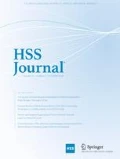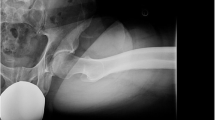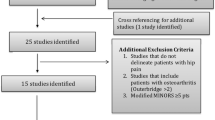Abstract
The primary diagnosis of femoroacetabular impingement is based on clinical symptoms, physical exam findings, and radiographic abnormalities. The study objective was to determine the radiographic findings that correlate with and are predictive of hip pain in femoroacetabular impingement (FAI). One hundred prospective patients with unilateral FAI symptoms based on clinical and radiographic findings were included in this study. All patients filled out a WOMAC pain questionnaire. Two independent-blinded surgeons assessed antero-posterior and lateral radiographs for 33 radiographic parameters of FAI. Correlations between pain scores and radiographic findings were calculated. A matched radiographic analysis was performed comparing symptomatic versus asymptomatic hips. Radiograph findings were also compared between males and females. Weak positive correlations were identified between increasing pain scores with radiographic findings of posterior wall dysplasia, presence of a shallow socket, and a more lateral acetabular fossa relative to the Ilioischial line. A symptomatic hip had a lower neck shaft angle, greater distance from Ilioischial line to acetabular fossa and larger distance from cross-over sign to superolateral point of the acetabulum when compared to the asymptomatic hip in the same patient. Symptomatic hips in males had more joint space narrowing, femoral osteophytes, higher alpha angles and larger, more incongruent femoral heads compared to females. Females had more medial acetabular fossa relative to the Ilioischial line and smaller femoral head extrusion index. Similar to other musculoskeletal conditions, radiographic findings of FAI are poor predictors of hip pain.

Similar content being viewed by others
References
Allen D, Beaule PE, Ramadan O, Doucette S. Prevalence of associated deformities and hip pain in patients with cam-type femoroacetabular impingement. J Bone Joint Surg Br. 2009; 91(5):589–594.
Beck M, Kalhor M, Leunig M, Ganz R. Hip morphology influences the pattern of damage to the acetabular cartilage: femoroacetabular impingement as a cause of early osteoarthritis of the hip. J Bone Joint Surg Br. 2005; 87(7):1012–1018.
Clohisy JC, Carlisle JC, Trousdale R, Kim YJ, Beaule PE, Morgan P, et al. Radiographic evaluation of the hip has limited reliability. Clin Orthop Relat Res. 2009;467(3):666–75.
Djurasovic M, Glassman SD. Correlation of radiographic and clinical findings in spinal deformities. Neurosurg Clin N Am, 2007; 18: 223–227.
Ezoe M, Naito M, Inoue T. The prevalence of acetabular retroversion among various disorders of the hip. J Bone Joint Surg Am. 2006;88(2):372–379.
Fitzgerald RH, Jr. Acetabular labrum tears. Diagnosis and treatment. Clin Orthop Relat Res. 1995 (311):60–68.
Ganz R, Parvizi J, Beck M, Leunig M, Notzli H, Siebenrock KA. Femoroacetabular impingement: a cause for osteoarthritis of the hip. Clin Orthop Relat Res. 2003(417):112–120.
Giori NJ, Trousdale RT. Acetabular retroversion is associated with osteoarthritis of the hip. Clin Orthop Relat Res. 2003(417):263–269.
Goodman DA, Feighan JE, Smith AD, Latimer B, Buly RL, Cooperman DR. Subclinical slipped capital femoral epiphysis. Relationship to osteoarthrosis of the hip. J Bone Joint Surg Am. 1997; 79(10):1489–1497.
Guevara CJ, Pietrobon R, Carothers JT, Olson SA, Vail TP. Comprehensive morphologic evaluation of the hip in patients with symptomatic labral tear. Clin Orthop Relat Res. 2006; 453:277–285.
Harris WH. Etiology of osteoarthritis of the hip. Clin Orthop Relat Res. 1986(213):20–33.
Ilizaliturri Jr VM, Orozco-Rodriguez L, Acosta-Rodríguez E, Camacho-Galindo J. Arthroscopic treatment of Cam-type femoroacetabular impingement: preliminary report at 2 years minimum follow-up. The Journal of Arthroplasty. 2008;23(2):226–234.
Ito K, Minka MA, 2nd, Leunig M, Werlen S, Ganz R. Femoroacetabular impingement and the cam-effect. A MRI-based quantitative anatomical study of the femoral head-neck offset. J Bone Joint Surg Br. 2001; 83(2):171–176.
Jager M, Wild A, Westhoff B, Krauspe R. Femoroacetabular impingement caused by a femoral osseous head-neck bump deformity: clinical, radiological, and experimental results. J Orthop Sci. 2004; 9(3):256–263.
Jamali AA, Mladenov K, Meyer DC, Martinez A, Beck M, Ganz R, Leunig M. Anteroposterior pelvic radiographs to assess acetabular retroversion: high validity of the “cross-over-sign”. J Orthop Res. 2007; 25(6):758–765.
Kalberer F, Sierra RJ, Madan SS, Ganz R, Leunig M. Ischial spine projection into the pelvis: a new sign for acetabular retroversion. Clin Orthop Relat Res. 2008; 466(3):677–683.
Lanyon P, O’Reilly S, Jones A, et al. Radiographic assessment of symptomatic knee osteoarthritis in the community: definitions and normal joint space. Ann Rheum Dis 1998; 57:595–601.
Leunig M, Ganz R. [Femoroacetabular impingement. A common cause of hip complaints leading to arthrosis]. Unfallchirurg. 2005;108(1):9–10, 12–17.
Leunig M, Podeszwa D, Beck M, Werlen S, Ganz R. Magnetic resonance arthrography of labral disorders in hips with dysplasia and impingement. Clin Orthop Relat Res. 2004(418):74–80.
Neogi T, Felson D, Niu J, et al. Association between radiographic features of knee osteoarthritis and pain: results from two cohort studies. BMJ. 2009; 339:b2844.
Notzli HP, Wyss TF, Stoecklin CH, Schmid MR, Treiber K, Hodler J. The contour of the femoral head–neck junction as a predictor for the risk of anterior impingement. J Bone Joint Surg Br. 2002; 84(4):556–560.
Peelle MW, Della Rocca GJ, Maloney WJ, Curry MC, Clohisy JC. Acetabular and femoral radiographic abnormalities associated with labral tears. Clin Orthop Relat Res 2005;441:327–333.
Pfirrmann CW, Mengiardi B, Dora C, Kalberer F, Zanetti M, Hodler J. Cam and pincer femoroacetabular impingement: characteristic MR arthrographic findings in 50 patients. Radiology. 2006; 240(3):778–785.
Reynolds D, Lucas J, Klaue K. Retroversion of the acetabulum. A cause of hip pain. J Bone Joint Surg Br. 1999; 81(2):281–288.
Rothenfluh DA, Reedwisch D, Muller U, Ganz R, Tennant A, Leunig M. Construct validity of a 12-item WOMAC for assessment of femoroacetabular impingement and osteoarthritis of the hip. Osteoarthritis Cartilage. 2008; 16(9):1032–1038.
Shindle MK, Voos JE, Heyworth BE, Mintz DN, Moya LE, Buly RL, Kelly BT. Hip arthroscopy in the athletic patient: current techniques and spectrum of disease. J Bone Joint Surg Am. 2007; 89 Suppl 3:29–43.
Siebenrock KA, Kalbermatten DF, Ganz R. Effect of pelvic tilt on acetabular retroversion: a study of pelves from cadavers. Clin Orthop Relat Res. 2003(407):241–248.
Siebenrock KA, Schoeniger R, Ganz R. Anterior femoro-acetabular impingement due to acetabular retroversion. Treatment with periacetabular osteotomy. J Bone Joint Surg Am. 2003; 85-A(2):278–286.
Tannast M, Goricki D, Beck M, Murphy SB, Siebenrock KA. Hip damage occurs at the zone of femoroacetabular impingement. Clin Orthop Relat Res. 2008; 466(2):273–280.
Tannast M, Kubiak-Langer M, Langlotz F, Puls M, Murphy SB, Siebenrock KA. Noninvasive three-dimensional assessment of femoroacetabular impingement. J Orthop Res. 2007; 25(1):122–131.
Tonnis D, Heinecke A. Acetabular and femoral anteversion: relationship with osteoarthritis of the hip. J Bone Joint Surg Am. 1999; 81(12):1747–1770.
Wenger DE, Kendell KR, Miner MR, Trousdale RT. Acetabular labral tears rarely occur in the absence of bony a bnormalities. Clin Orthop Relat Res. 2004(426):145–150.
Author information
Authors and Affiliations
Corresponding author
Additional information
Each author certifies that he or she has no commercial associations (e.g., consultancies, stock ownership, equity interest, patent/licensing arrangements, etc.) that might pose a conflict of interest in connection with the submitted article.
Institutional Review Board was obtained. Informed consent was given prior to inclusion in this study by all patients. This study was carried out in accordance with relevant regulations of the US Health Insurance Portability and Accountability Act (HIPAA).
Levels of Evidence: III
Rights and permissions
About this article
Cite this article
Ranawat, A.S., Schulz, B., Baumbach, S.F. et al. Radiographic Predictors of Hip Pain in Femoroacetabular Impingement. HSS Jrnl 7, 115–119 (2011). https://doi.org/10.1007/s11420-010-9192-x
Received:
Accepted:
Published:
Issue Date:
DOI: https://doi.org/10.1007/s11420-010-9192-x




